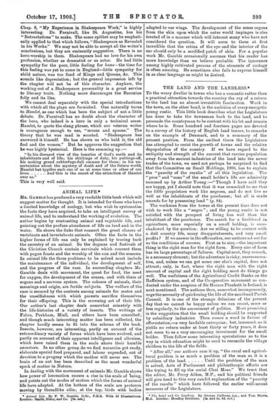ANIMAL LIFE.* Mn. GAMBLE has produced a very readable little
book which will suggest matter for thought. It is intended for those who have a limited knowledge of zoology, but who wish to systematise the facts they have acquired, to take an intelligent survey of animal life, and to understand the working of evolution. The author begins by contrasting animal and vegetable life, and pointing out the profuse abundance of life on land and in the water. He shows the links that connect the great classes of vertebrate and invertebrate animals. Often the facts in the higher forms of life can only be explained by tracing back the ancestry of an animal. So the dogmas and festivals of the Christian Church contain survivals which connect them with pagan feasts and the worship of the sun and the seasons. In animal life the three problems to be solved must include the maintenance of the individual, the development of self, and the progress of the race. In succeeding chapters Mr. Gamble deals with movement, the quest for food, the need for oxygen, the development of the senses, and with them of organs and a nervous system. The colours of animals, their meanings and origin, are fertile subjects. The welfare of the race is secured by the contests among animals for mates and the unselfishness with which parents sacrifice themselves for their offspring. This is the crowning act of their life. Our author's last chapter deals somewhat minutely with the life-histories of a variety of insects. The writings of Fabre, Peckham, Mall, and others have been consulted ; and though much interesting matter has been collected, the chapter hardly seems to fit into the scheme of the book. Insects, however, are interesting, partly on account of the extraordinary variety of forms which have been evolved, and partly on account of their apparent intelligence and altruism, which have raised them in the scale above their humble ancestors. In no other group do we find nurseries got ready, elaborate special food prepared, and labour expended, out of devotion to a progeny which the mother will never see. The brain of an ant has been described as the most wonderful speck of matter in Nature.
In dealing with the movement of animals Mr. Gamble shows how power of locomotion causes a rise in the scale of being, and points out the modes of motion which the forms of animal life have adopted. At the bottom of the scale are protozoa moving by threadlike cilia; at the top, birds with bodies
• Animal Life. By F. W. Gamble, D.Sc., P.M& With 63 illustrations. London: Smith, Elder, and Co. [6a. notd
adapted to use wings. The development of the sense organs from the skin upon which the outer world impinges is also treated of in a manner which will interest many who have not considered the question. It will seem to them at first incredible that the retina of the eye and the interior of the ear should only be a modified patch of skin. For a popular work Mr. Gamble occasionally assumes that his reader has more knowledge than we believe probable. The ignorance among highly cultivated persons of the elements of zoology is often amazing. He sometimes also fails to express himself in as clear language as might be desired.














































 Previous page
Previous page